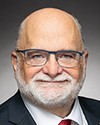Mr. Chairman and members of the committee, good morning. Thank you for inviting me to appear before you today.
I first want to acknowledge the Algonquin people on whose traditional ancestral homelands we are assembled here today.
My name is Kim Beaudin. I'm a status Indian from Alberta.
I want to add a little bit to this. My original reserve is number 132. It was known as the Michel band and Callihoo reserve. We are the only reserve in Canada to be expunged by the federal government, in 1958. There's quite a bit of history there.
I'm also the president of the Aboriginal Affairs Coalition of Saskatchewan. I've been there for the past seven years. We're a regional affiliate of the Congress of Aboriginal Peoples.
I also do outreach work with STR8 UP. It's a program for ex-gang members. It's the only program of its kind in Canada. When it comes to a grassroots perspective, I'm definitely into that mode.
I was also a justice of the peace for the Province of Saskatchewan for five years. I worked within the criminal justice system. I got quite a bit of experience from that.
I'm here with Jerry Peltier, former grand chief of Oka Mohawk community, a Mohawk nation territory in Quebec. He's the senior adviser to our National Chief Dwight Dorey. As you know, Dwight Dorey couldn't be here today as a result of the Supreme Court ruling that's coming down this morning, a very important ruling for Métis and non-status Indians.
Let me tell you a little bit about our organization.
The Congress of Aboriginal Peoples is one of the five national indigenous organizations recognized by the federal government in Canada and by the provincial and territorial governments, as well as the the international community.
For over 40 years, since 1971, CAP, formerly known as the Native Council of Canada, has, as a national indigenous representative organization, represented the interests of Métis, off-reserve status Indians, and non-status indigenous people living in urban, rural, remote, and isolated areas throughout Canada, including the Inuit of southern Labrador. We represent more than 70% of indigenous peoples across Canada.
The congress works closely with the provincial and territorial organizations, known as PTOs, and other indigenous organizations and advocates on their behalf on a national level. Each PTO is a provincially or territorially incorporated organization. Affiliates provide research and advocacy support to their members and carry out a wide range of programs and services for their constituents.
The board of directors is composed of the national chief, the vice-chief of CAP, our elected leaders of the PTOs, and the national youth representative of the Congress of Aboriginal Peoples, the National Youth Council.
The national chief and vice-chief are elected every four years at the annual general assembly by delegates chosen from each of the affiliate organizations, the national executive, and a youth representative from each of the provincial affiliates. Delegates at these assemblies discuss issues and proposals and develop policy platforms related to off-reserve indigenous peoples.
Recently we rebranded ourselves as the Indigenous Peoples’ Assembly of Canada, known as IPAC, because we found the word “indigenous” to be more inclusive, and it resonates with today's international standard.
Today we are here to discuss the importance of access to justice and human rights for indigenous peoples and representative organizations.
I must say that I was encouraged by the Prime Minister's words in his mandate letter to the ministers. He said:
No relationship is more important to me and to Canada than the one with Indigenous Peoples. It is time for a renewed, nation-to-nation relationship with Indigenous Peoples, based on recognition of rights, respect, co-operation, and partnership.
To the Minister of Justice and Attorney General of Canada, the Prime Minister said:
In particular, I expect you to work with your colleagues and through established legislative, regulatory, and Cabinet processes to deliver on your top priorities:
You should conduct a review of the changes in our criminal justice system and sentencing reforms over the past decade with a mandate to assess the changes [or]...other initiatives to reduce the rate of incarceration amongst Indigenous Canadians....
Work with the Minister of Public Safety and Emergency Preparedness and the Minister of Indigenous and Northern Affairs to address gaps in services to Aboriginal people and those with mental illness throughout the criminal justice system...[and]
Support the Minister of Canadian Heritage to restore a modern Court Challenges Program.
I must caution that, traditionally, indigenous aboriginal peoples in Canada have identified themselves as specific nations, such as Mi'kmaq, Maliseet, Mohawk, Ojibway, Seneca, Chipewyan, Carrier, Dakota, Nootka and onward, as one of the 60 or so indigenous nations of Canada. This is a definition of nation to nation geared toward band councils and Indian Act bands and chiefs. There are some issues with this definition.
As you are aware, the United Nations Declaration on the Rights of Indigenous Peoples is a most comprehensive international human rights document, which addresses indigenous economic, social, cultural, and political rights and outlines minimal standards of dignity, survival, and well-being of indigenous peoples.
Governments must use the declaration in combination with consultation of indigenous peoples as a basis for reviewing and reforming laws and policies, to ensure that all indigenous peoples' rights are upheld without discrimination.
I am not sure how many of you are aware of a Macleans magazine headline reading, "You'll Never Get Out". The article said:
Canada’s crime rate just hit a 45-year low. It’s been dropping for years—down by half since peaking in 1991. Bizarrely, the country recently cleared another benchmark, when the number of people incarcerated hit an all-time high.
If you dig a little further into the data, an even more concerning picture emerges. While admissions of while adults to Canadian prisons declined through the last decade, indigenous incarceration rates were surging, up 112% for aboriginal women. Already 26% of the women and 25% of the men sentenced to provincial and territorial custody in Canada are indigenous, a group that makes up just 4% of the national population. Add in the federal prisons and indigenous inmates account for 22% of the total incarcerated population.
We need to change this. The justice system must be reviewed.



